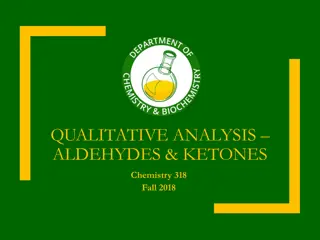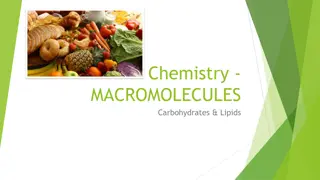Qualitative Tests of Lipids and Derived Lipids Overview
Qualitative tests of lipids distinguish between oil, neutral fat, saturated fatty acids, and unsaturated fatty acids using methods like the copper acetate test. Derived lipids include substances like cholesterol and fat-soluble vitamins that are either soluble in lipids or derived from lipids through hydrolysis. Fatty acids are classified into saturated and unsaturated types, with essential fatty acids like linolenic acid and linoleic acid playing crucial roles. The copper acetate test helps in identifying different lipid components through specific reactions.
Download Presentation

Please find below an Image/Link to download the presentation.
The content on the website is provided AS IS for your information and personal use only. It may not be sold, licensed, or shared on other websites without obtaining consent from the author.If you encounter any issues during the download, it is possible that the publisher has removed the file from their server.
You are allowed to download the files provided on this website for personal or commercial use, subject to the condition that they are used lawfully. All files are the property of their respective owners.
The content on the website is provided AS IS for your information and personal use only. It may not be sold, licensed, or shared on other websites without obtaining consent from the author.
E N D
Presentation Transcript
Derived lipids . They are substances that are soluble in lipid or derived from the lipids by hydrolysis; for examples, cholesterol and fat soluble vitamins. http://2.bp.blogspot.com/-rZ9GgpNvt6A/USY70k2fJGI/AAAAAAAABUU/VU1JbsXljXQ/s1600/Cholesterol.gif
Fatty Acids Classification a-saturated fatty acids Saturated fatty acids have no double bonds ,side chian are a)Short chain From 4 to 10 Carbon atoms ,and present as liquid in room Temp. e.g acetic acid and butyric acid a)Long chain: More than 10 Carbone atoms, present in solid at room Temp. e.g. Palmatic (16) acid and Stearic(18) acid
Unsaturated fatty acids have one or more double one or more double bonds between carbon atoms,side chain has at least one doublebond. a)Essential Fatty acids: linolenic acid18-C, 3 double bond ( -3) Linoleic acid 18-C, 2 double bond ( -6) b)Non essential Fatty acids: Can be synthesized in the body: Oleic acid
1-Copper acetate test This test is used to distinguish between oil or neutral fat and This test is used to distinguish between oil or neutral fat and fatty acid saturated and unsaturated. fatty acid saturated and unsaturated. Principle: Principle: The copper acetate solution does not react with the oils (or fats), while saturated and unsaturated fatty acids react with copper acetate to form copper salt. Copper salt formed in the case of unsaturated fatty acids can only be extracted by petroleum ether.
Copper acetate test olive oil: olive oil: notice that petroleum ether upper lay containing the dissolved oil and appears colorless, aqueous solution remains blue in the bottom. petroleum ether and dissolved oil petroleum ether and dissolved oil copper acetate copper acetate oleic acid oleic acid the upper layer of petroleum ether becomes green as a result of copper oleate. The lower layer becomes less in blue. copper copper oleate oleate in the petroleum ether in the petroleum ether copper acetate copper acetate
Method 1. Take two test tubes add 3 ml of petroleum ether and an equal volume of a solution of copper acetate. 2. Add 0.5 ml of each sample in each tube 3. Shake the tube and leave it for some time. Result: Result: Tube Tube Observation Observation Comments Comments Olive oil Oleic acid
2-Qualitative estimation of Cholesterol by Liebermann - BurchardTest Principle: Principle: Liebermann - Burchard Test , is a chemical estimation of cholesterol, the cholesterol is react as a typical alcohol with a strong ,concentrated acids; the product are colored substances. Acetic anhydride are used as solvent and dehydrating agents, and the sulfuric acid is used as dehydrating and oxidizing agent . A positive result is observed when the solution becomes red or pink , then purple , blue blue, and finally bluish bluish green green color. Reaktionsfolge der Liebermann-Burchard-Reaktion
Method Method Dissolve a few crystals of cholesterol in 2 ml of chloroform in a dry test tube Now add 10 drops of acetic anhydride Add 2 to 3 drops of conc. sulfuric acid Record your result Tube Tube Observation Observation Comments Comments Cholesterol Olive Oil
Unsaturation Test: Principle Principle: All neutral contain glycerides of some unsaturated fatty acids. These unsaturated fatty acids become saturated by taking up iodine. If the fat contains more unsaturated fatty acids, it will take up more iodine.
Method: Equally into 4 flask Add 10 ml of Chloroform then 10 drops of Hub s iodine reagent ,the chloroform shows pink color due to presence of iodine. presence of iodine. To one test flask add the oil sample drop by drop shaking the tube vigorously for about 30 seconds after addition of each until the pink color is discharged and count the number of drops. count the number of drops. The pink color is discharged owing to the taking up of iodine by the unsaturated fatty acids of the oil. Compare unsaturation , it should be remembered that more the Compare unsaturation , it should be remembered that more the number of drops required to discharge the pink color, the less is number of drops required to discharge the pink color, the less is the unsaturation. the unsaturation. pink color due to
Results: Sample Number of drops added from the sample Conclusion Mustard oil Mustard oil coconut oil coconut oil olive oil olive oil saturated fat saturated fat
Acrolein test The "acrolein test" is used to detect glycrol or fats Most lipid are found in the form of triglycerides, an ester formed from Most lipid are found in the form of triglycerides, an ester formed from glycerol and fatty acids. glycerol and fatty acids. Principle: Principle: When a fat is heated strongly in the presence of a dehydrating agent such as KHSO4, the glycerol portion of the molecule is dehydrated to form the unsaturated aldehyde, acrolein CH2=CH-CHO , which can be distinguished by its irritating acrid smell and as burnt grease. Other way to detect lipids is by dye Sudan IV (general dye for lipid ), which produce red color with lipid.























